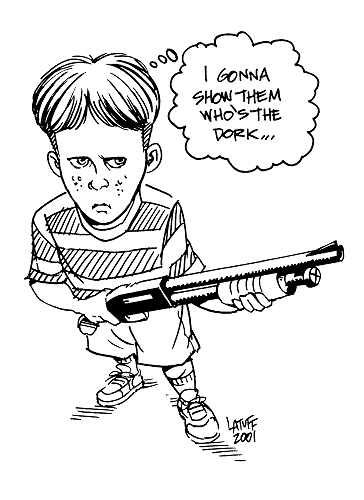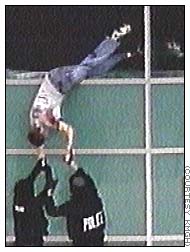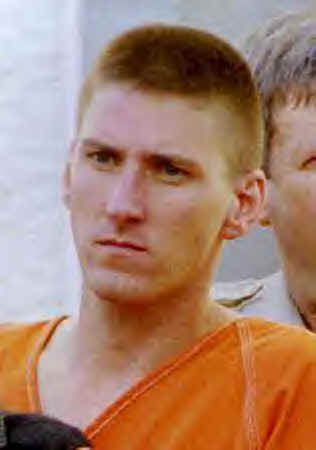 Tim Wise, a Nashville-based writer and activist, has written an excellent essay titled School Shootings and White Denial. Read it for the full effect. Here's what Wise says is wrong with America:
Tim Wise, a Nashville-based writer and activist, has written an excellent essay titled School Shootings and White Denial. Read it for the full effect. Here's what Wise says is wrong with America: Tim Wise, a Nashville-based writer and activist, has written an excellent essay titled School Shootings and White Denial. Read it for the full effect. Here's what Wise says is wrong with America:
Tim Wise, a Nashville-based writer and activist, has written an excellent essay titled School Shootings and White Denial. Read it for the full effect. Here's what Wise says is wrong with America:
I'll tell you what went wrong and it's not TV, rap music, video games or a lack of prayer in school. What went wrong is that white Americans decided to ignore dysfunction and violence when it only affected other communities, and thereby blinded themselves to the inevitable creeping of chaos which never remains isolated too long. What affects the urban "ghetto" today will be coming to a Wal-Mart near you tomorrow, and unless you address the emptiness, pain, isolation and lack of hope felt by children of color and the poor, then don't be shocked when the support systems aren't there for your kids either.
What went wrong is that we allowed ourselves to be lulled into a false sense of security by media representations of crime and violence that portray both as the province of those who are anything but white like us. We ignore the warning signs, because in our minds the warning signs don't live in our neighborhood, but across town, in that place where we lock our car doors on the rare occasion we have to drive there. That false sense of security — the result of racist and classist stereotypes — then gets people killed. And still we act amazed.
As Wise implies, white-boy shooting is endemic to America. What were Sam Adams and his "Indians" at the Boston Tea Party but white-boy rebels playing a prank on their British "parents"? Every pioneer or cowboy who sought to tame the frontier and eliminate the "savages" is inheritor to this grand tradition.
But this truth is unpleasant; it contradicts our Judeo-Christian ethic of loving our neighbor as ourselves. So rather than live up to Jesus's teachings, we concoct fantasies to relieve us of responsibility. The hostile Indians were the problem...the uppity Negroes...the filthy immigrants...the teeming Latinos ("they keep coming and coming"). Everyone's a problem but white, middle-class, Anglo-Saxon Protestants.
Wise reactions
To continue, here's some commentary on Wise's essay from the LA Times, 3/13/01:
It's no surprise that Wise touched a nerve, says Raymond A. Winbush, director of the Race Relations Institute at historically black Fisk University in Nashville. Winbush had 15 or 16 copies of the article forwarded to him.
"As an African American, I'm tired of hearing every time one of these shootings occurs someone says, 'Oh, my goodness, these are aberrations. There is something with this kid, but there isn't anything wrong with the system.' What Tim's article does as a white person is he deconstructs those arguments."
.
.
.
"When you're white, you have the luxury of invisibility," Wise said. "Anything that peels back the veil that keeps you invisible and makes you opaque is jarring and frightening to white folks. You don't ever have to think about being a dominant group member. Your world is natural and normal. It's not white. It just is."
Among the passionate e-mails to Wise was one from a 33-year-old white mother of a 7-year-old boy in Merced: "When children are locked up in 'Fantasy Land' a.k.a. White America, their mind closes off and with it goes compassion for other human beings," Lisa Coelho wrote. "Jeffrey Dahmer, Ted Bundy, Timothy McVeigh, Charles Manson, all dysfunctional males from white society. If any of these men were black, it would have been a hate-fest on the black community and its violent nature. The dysfunctional (white) kids with guns at home/school, they're loners, picked-on victims."
He also was lauded by many white suburbanites including some who live near Santana High School in Santee. Anita Carol Smith, a former teacher in Santee, wrote:
"I taught at Santana's 'sister school' in the next community for 10 years, and I have to say that you really 'nailed it' when it comes to obliviousness to the profile: young, white, outcast, picked on, angry, armed."
Other whites were critical, accusing him of being racist or anti-white. Cindy Mitchell, for instance, wrote: 'You are trying to reduce school violence into one simple cause when there are many. Things such as genetic propensity, lack of support in the schools and home, dysfunctional homes, unavailable parents, overpopulated schools . . . and inattention to warning signs. To say it is simply a matter of one thing or another is irresponsible."
For his part, Wise offers no solutions to the problem, just points out that "white-blind," as he calls it, is about privilege, about being a member of the dominant race and class, and in the case of the mass school shootings, the dominant gender. White suburban boys grow up with a sense of entitlement that is tough for any adult to knock, Wise says.
"Being teased is horrible, but how does that compare to being treated in a racist manner, or being poor? It just shows when you're a part of the dominant group, your skin is very thin," he says. "Not to romanticize the suffering of minorities, but when you're buffeted by poverty or racism, you build up defense and coping mechanisms. You are able to cope with disappointment and failure and navigate the obstacles in your life. White people don't have to grow up that way. There is a flip side to racial privilege. There are dysfunctions, things about being dominant and privileged that we really ought to rethink."

Rob's comment
I differ with only a couple of things in Wise's masterful essay. For one, TV, rap music, video games, and other forms of influential media have gone wrong. When Wise writes that "white Americans decided to ignore dysfunction and violence when it only affected other communities," what does he think caused that decision? Did whites wake up one day and decide they cared only about themselves?
No. By focusing on violence and crime, especially among minorities...by stereotyping minorities when it portrays them at all...the media has contributed greatly to white America's so-called decision. Desensitizing people is exactly what the media does, according to many studies. It teaches us that we don't have to take violence personally because it affects only "them," not "us."
Also, I'd hesitate to distinguish so starkly between white and minority America. Or rather, I'd offer a theory to unify them. Here goes:
Both whites and minorities want to achieve the American Dream. In adolescence, when the dream seems impossible or difficult to reach, all children tend to rebel. The result is your classic sex, drugs, and rock 'n' roll.
But minorities have fewer opportunities than whites to achieve the American Dream. More of them fail to achieve it. In response, they tend to lash out in greater numbers. They join gangs and commit crimes or drop out and become pregnant. In subcultures such as Native America, they become drunk or commit suicide because the anguish is too great to bear.
Whites have more opportunities than minorities to achieve the American Dream. Fewer of them fail to achieve it. When they do fail, they still believe they deserve the Dream. If smoking weed or getting tattooed doesn't drown their sorrows, they join subcultures like the Tim McVeigh militias, neo-Nazi skinheads, or Rush Limbaugh dittoheads. Or they lash out individually with guns. Either way, they demand the respect and power they believe is their birthright.
For more on the cultural causes of violence, see Culture Kills in Red Lake Tragedy and Why Americans Commit Suicide.
Gangs or lone gunmen?
Madison Shockley, a member of the Board of Directors of the Southern Christian Leadership Conference/l.a., elaborates on the different responses of suburban and urban kids to social stress. From the LA Times, 3/28/01:
To get back to the mystery of why these events happen in suburban and rural schools and not (so far) in inner-city schools, we have to examine the social matrix of the inner city. The same psychological problems exist but find a different outlet there. In the inner city, some of these weak and bullied kids find protection and a degree of acceptance in a gang.
Being a member of a gang allows them to insulate themselves from the raw and seemingly relentless assaults on their ego that they would otherwise have to endure. As gang members, they are vicariously empowered by the fearful respect given to the group. Even the bullies are at bay because, in the inner city, the bullies are more typically the gang leaders.
The violence of the gang is often random, but it is not suicidal. Gang members always plan to get away. Which explains the drive-by. They may spray the front of a school or a house in a rival's territory, but they don't stay long enough for the body count to climb into the dozens. Neither have they engaged the technology of the bomb.
Another reason the Samson syndrome doesn't happen in the inner city is because children there who have the most potential for violence are in gangs, so they are easily identified. This allows the community to respond with gang diversion and prevention programs.
In the suburban-rural setting, these weak and damaged kids add isolation to their predicament. While acting in tandem at times, this arrangement does not rise to the level of a gang. They are basically loners who live on the margins of their culture, noses pressed up against the glass of the hated mainstream society. They live isolated lives, even in their own homes, where parents do not even bother to enter their rooms. But by entering their parents' rooms, many of these children find the weapons they need for their deadly acts.
The upshot, as Dolores Long put it in a letter to the LA Times, 3/8/01: "We have created a desensitized society that neither values nor teaches compassion. Listen to me. Listen to me. Listen to me. BANG! Now I have your attention."

Kids or adults?
Mike Males, author of Kids and Guns: How Politicians, Experts, and the Press Fabricate Fear of Youth, had this to say in the LA Times, 3/11/01:
About every 10 days, a New York Times review found, a mass, random, public shooting occurs in the United States. Each is a tragedy with flesh-and-blood victims and grieving survivors tormented that they missed warning signs of the violence. The shooter usually is a middle-class or affluent white male rejected or persecuted by peers, coworkers, students, wife, girlfriend, employer—everyone. Most often, he is middle-age; occasionally, a young adult or teenager.
Teenagers who avenge affronts by spraying schoolmates with bullets have more in common with "dissed white male" adult rage killers than with other teens. Authorities and reporters who portray school shootings as "youth" or "school" phenomena are missing this big picture.
Males goes on to say that "If the U.S.'s overall murder rate was as low as that in high schools, America would be safer from homicide than Sweden." His point seems to be in his book title: that we're fabricating a fear of youth. Does that have any validity?
I don't think so. Much of the commentary about how our culture treats people applies to both adults and children. So what if someone manages to withstand the pressure to go postal until he's 18 or 21?
A Manson or McVeigh doesn't go bad suddenly when he hits adulthood. Our culture breeds aggression and violence into him from the beginning. Even if a boy does nothing overtly bad, we should worry about what we're teaching him. "The child is father to the man," as they say.
America's culture has grown increasingly selfish, narcissist, and greedy over the decades. Yet we've done little about it since the revolutionary 1960s. These days we tout our exceptional values—"that more is better and that you are not really good if you are not really rich," as one expert put it. No wonder people go a little crazy when they can't live up to that standard.
When you add Sweden's murder rate to our already exceptionally high murder rate, you get...an even higher murder rate. That kids are shooting each other is a problem in its own right, but it's also an indicator of our general cultural malaise. All people, not just children, need an environment that provides compassion, respect, and meaning. Twenty-first-century America isn't it.
The killing fields: our severe male problem
Males's protest is a distraction from the real issue. Violence is an American...white...and male problem. It's a problem of the mainstream culture, not some aberrant minority groups. Whether men or boys do most of the killings, shootings, and beatings is a detail.
An article on the war in Afghanistan, Preaching Pacifism Amid War, makes the same point. In it, singer/storyteller Utah Phillips talks about why men go to war and women don't. From the Sacramento News and Review, 11/29/01:
Thinking of the woman in that photo or the mothers of those boys, [Phillips] believes "that women know a lot more about the real consequences of war and killing because they provide the fodder; they endure the consequences." Women, children, old people, disabled people are not the ones doing the killing, he says.
"It's young men with guns. We don't have a problem with violence in the world, we've got a serious male problem and we're not looking at it that way." In our newspapers, he seldom reads of women responsible for murder or other violent crimes.
The problem lies in "the way men are enculturated. I can't define it, because I've had that anger in me. That carried me into Korea, as a soldier carrying a loaded rifle. I was one of those young men with a rifle and I'm willing to shut up and listen if women will get together and give me some ideas. It's not a problem of violence, it's a severe male problem. We get at that one and figure it out, most of the other problems will solve themselves."
P.S. Kind of ironic to see someone named Males defending males. Maybe he doesn't want his name besmirched.
More on why white boys keep shooting
Why white man hate Indians
Related links
Victor or victim: our new national anthem?
Violence in America
America's cultural mindset
|
. . . |

|
All material © copyright its original owners, except where noted.
Original text and pictures © copyright 2007 by Robert Schmidt.
Copyrighted material is posted under the Fair Use provision of the Copyright Act,
which allows copying for nonprofit educational uses including criticism and commentary.
Comments sent to the publisher become the property of Blue Corn Comics
and may be used in other postings without permission.